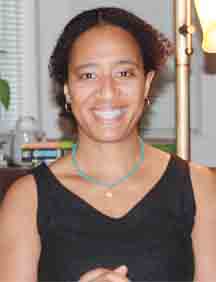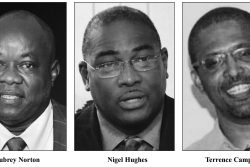Guyana Prize Chairman of the Jury Victor Ramraj in his official report commented on the excellence of the poetry in the Guyana Prize 2010 which prompted the panel to select a shortlist of six books. It was declared a very strong field all with a realistic claim to the title. This was also a statement about Guyanese poetry, its current strength and the notable advance of a number of new poets, poets who have recently joined the establishment, and those who, although they have been writing for several years, only began publishing and have been elevated to this top order in recent times. Some of these have only just produced their second books.
 The 2010 shortlist included a number of former winners of the Best First Book Prize, some who were ‘discovered’ by the Prize, and others whose development may be linked to their participation and success in the Prize.
The 2010 shortlist included a number of former winners of the Best First Book Prize, some who were ‘discovered’ by the Prize, and others whose development may be linked to their participation and success in the Prize.
Berkley Semple may be regarded as the newest of these, having first come to notice with his winning first book The Lamplight Teller in 2004. With his third published book, he has now joined the ranks of top-flight Guyanese poets. Both Stanley Greaves and Maggie Harris are members of the establishment who were contenders in 2010, but with only their second published books. Both won the Prize with their first. Brian Chan, another past First Book winner, and Sasenarine Persaud have long been established poets.
The jury felt that The Journey to Le Repentir had a number of advantages over the other five, and this was only another statement about the emphatic rise of Mark McWatt to a place at the very top of Guyanese poetry. This is his third book of verse and the second of them to have won a Prize. The following is how the jury described the winning collection.
“Mark McWatt’s The Journey to Le Repentir retraces the growth of a curious child in the remote northwest of Guyana, paralleling the speaker’s transition to adulthood with the journey of an Elizabethan sea-captain searching for El Dorado centuries earlier. The latter parts of the collection address adolescent passions and the challenges of mid-life and old age, juxtaposing personal and political creation/destruction and the remorse of a Frenchman whose accidental fratricide drove him to rename his estates La Penitence and Le Repentir.”
Most of the book is autobiographical with the experiences of McWatt himself at the centre of its tales and consciousness. This choice of subject and strategy was considered “safe” by at least one assessor, who felt other poets took more risks, but in other ways they account for the remarkable success of the book. The poet spent most of his childhood in different parts of the interior “Heartland” of Guyana since his father was working in those locations, followed by secondary schooling at St Stanislaus College in Georgetown, university in Canada and a distinguished academic career in Barbados. But while these stages of life inform the poetry in the book, McWatt admits the poems do not relate “true” incidents or experiences. Where he succeeds so well with the relations to autobiography, is the way he manages to use that background of “true” experiences to fictionalise, merging and linking them to important themes, myths and other lives.

For example, virtually growing up in the hinterland was a profound experience that has informed his imagination and consciousness ever since in a way he has never been able to erase or exhaust. He has returned to it inexhaustably in such a way that it has created much of his verse and fiction. His relationship with the rainforest is metaphysical and so close that he regards the landscape itself as the real poems. He sets them down on paper, but the landscape, not McWatt, is the real author as he discovers “that all the world’s poems, or none of them, are mine.”
That formative background never left him and has contributed considerably to all three books, Interiors (Dangaroo, 1991), The Language of El Dorado (Dangaroo, 1994) and The Journey to Le Repentir (Peepal Tree, 2009). What lifts the verse in this most recent book above the “safety” of autobiography is the way he integrates it first with the landscape, then with the mythical and historical Elizabethan resonances of El Dorado, and with the story of Pierre Louis de Saffon (1724-1784). Saffon was the Frenchman who exiled himself to Demerara after killing his brother and feeling guilty and penitent. He bought plantations in Guyana which he named La Penitence, Le Repentir and Le Regret. McWatt executes a pun with the title of the collection as he fictionalises Saffon’s story along with his own background and the kinds of “intimations of mortality” reflected in at least one section of the book.
The strength of McWatt’s book was further emphasized when it was also selected as the best of another highly praised field in the first Caribbean Prize. That shortlist of six also included Jennifer Rahim who is highly respected as one of the outstanding poets to have recently emerged in Trinidad and Tobago. Her Approaching Sabbaths (Peepal Tree) was among Undraining Sea (Egg Box) by Vahni Capildeo, also of Trinidad and Clever Backbone (Bloodaxe) by Guyana’s John Agard and two Jamaican poets. The jury specifically justified a list of six by extolling the merits of the entries in the poetry category. This also made yet another statement about the exalted place of Guyanese poetry in contemporary Caribbean literature and the meteoric rise of McWatt to its top tier in both poetry and fiction.
Among the significant observations arising from the Best Fiction Category in the Caribbean Prize are that the winner is from Haiti, and that all five books on the shortlist were written by women. The past thirty years in West Indian literature has marked the increasingly important place claimed by female writers. It is not just the increase in numbers but their contribution to the definition of the literature by the preoccupations that, because of their output, have become a part of it. They have made it possible for Caribbean women writers to become a subject of substantial study in addition to the several new varieties in styles and uses of language, both standard and creole, that they have fashioned.
The first Caribbean Fiction winner is Myriam JA Chancy of Haiti with The Loneliness of Angels (Peepal Tree, 2010). Largely pushed by the prominence of such women writers as Danticat, Haitian writers have settled in the mainstream of West Indian fiction. They have strengthened the interest in comparative literature in the Caribbean which had already begun to look to the French Departments of Martinique and Guadeloupe. That a Haitian has claimed the title has virtually legitimised the Prize as truly Caribbean because of its unhesitating inclusion, and now recognition of work from the non-anglophone West Indies.
Chancy is neither a stranger nor a newcomer since her first novel Spirit of Haiti was shortlisted in the Best First Book Category of the Commonwealth Writers Prize 2004. She has also published critical works on Haitian literature and is an academic at the University of Cincinnati, USA.
The Loneliness of Angels is set in Haiti, Canada, Paris, New York and Ireland and is multi-layered in its shifting narratives and central characters. It focuses on a Haitian middle-class woman of mixed racial ancestry and three other central characters with whom she has close contact and with whom her fortunes are inter-linked. There are many interests which Chancy succeeds in bringing together artistically. For instance, one of the major characters achieves international pop-star success as a musician but falls to a degraded existence as a drug addict, and in that state, is responsible for the murder of the heroine. When he is finally rehabilitated and returned to normal life he ends up on a project in Ireland, which happens to be her ancestral homeland. Having, in the depths of his addiction, caused the heroine to be murdered, he finds redemption in the place of her ancestral origins.
In this way Chancy also links troubled contemporary Haiti to the famine-stricken Ireland of the nineteenth century. Ironically, the heroine’s maternal ancestor flees those poverty-stricken conditions in 1847 to find a better life in Haiti. Other historical connections are made along with references to Haiti’s recent history of political terror under the reign of Papa Doc. The main characters are all Haitian middle class and it is significant that the novel should focus that ‘privileged’ existence in a country plagued by poverty, a brutal history, natural and man-made disasters. Yet those horrendous elements are a crucial part of the novel as well, as elements from the other sides of the country flow over into the lives of the protagonists.
One of them lives a constant nightmare as she is visited in dreams and visions by the victims of Duvalier’s Tonton Macoutes. Even after she flees to Canada she does not seem to escape as her troubled past might well have been responsible for her suspected suicide. There are spiritual connections as years later her voice intervenes in the nick of time to save her daughter from a near-fatal car crash. There are several other inter-links with the spiritualism of Haitian traditional culture and the local Kreyol occasionally intrudes into the standard English narration.
The Loneliness of Angels is ambitious, but satisfactorily handles all its many dimensions to be an important document of contemporary Haiti as affected by its recent history and its connections with the outside world. Its exposure, through the Prize, has allowed yet another of many windows into francophone West Indian fiction for the benefit of comparative literature in the Caribbean.









